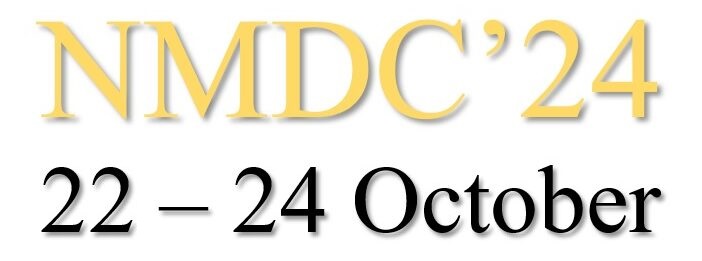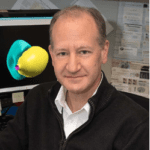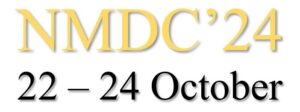Speakers
NMDC 2021 Plenary and Invited Speakers include:
PLENARY
- Naomi Halas, Department of Electrical and Computer Engineering, Rice University; “Nanomaterials and Light for Sustainability and Societal Impact”
- Mark Johnson, D-Wave Systems Inc; “Practical Quantum Computing”
- Jessica E. Koehne, NASA Ames Research Center; “Carbon Nanomaterial Based Sensors and Devices for NASA Missions”
- Tatiana Segura, Duke University; “Annealed Hydrogel Microparticles as Scaffolds for Tissue Repair”
- Dong Sun, Department of Biomedical Engineering, Center for Robotics and Automation, City University of Hong Kong; “Microrobotic Systems for Cell Manipulation”
- Xiaoying Zhuang, Department of Maths and Physics, Leibniz University Hannover; “Multiscale modelling and optimization of flexoelectric nano structures”
Naomi Halas
Nanomaterials and Light for Sustainability and Societal Impact Naomi Halas, Stanley C. Moore Professor of Electrical and Computer Engineering, Rice University Abstract: Metallic nanoparticles, used since antiquity to impart intense,…
Mark Johnson
Practical Quantum Computing Mark Johnson, D-Wave Abstract: Quantum computing has entered an era where differentiation is better measured in the variety and value of customer applications than it is with…
Jessica E. Koehne
Carbon Nanomaterial Based Sensors and Devices for NASA Missions Jessica E. Koehne, NASA Ames Research Center Abstract: Carbon nanomaterials have been investigated for their use in NASA missions due to…
Tatiana Segura
Annealed Hydrogel Microparticles as Scaffolds for Tissue Repair Tatiana Segura, Duke University Abstract: Injectable materials that can conform to the shape of a desired space are used in a variety…
Xiaoying Zhuang
Multiscale modelling and optimization of flexoelectric nano structures Xiaoying Zhuang, Chair of Computing Science and Simulation Technology, Institute of Photonics, Department of Maths and Physics, Leibniz University Hannover Abstract: Flexoelectricity…
NMDC & CEIDP JOINT SESSIONS SPEAKERS
Tuesday, December 14
PLENARY SESSION 14:00-15:30
- Davide Fabiani, University of Bologna, “Piezoelectric Nanofibers for Smart Material Development”
- Christopher Homes, Brookhaven National Laboratory; “Giant polarization in nanodielectrics”
SPECIAL SESSION 16:30-18:10
- Elena A. Rozhkova, Argonne National Laboratory; “Merging Nanotechnology & Synthetic Biology toward Directed Evolution of Energy Materials”
- Qiming Zhang, Pennsylvania State University, “Dilute Nanocomposites – A New Class of Polymer Nanocomposites That Exploit Nanointerface Effects in Enhancing Dielectric Performance”
- Chuan Seng Tan, Nanyang Technological University, Singapore, “Development, Testing, and Integration of Silicon and Glass Substrates for Advanced Ion Trap Design”
Davide Fabiani
Piezoelectric Nanofibers for Smart Material Development Davide Fabiani, University of Bologna Abstract: This paper illustrates that multifunctional materials with piezoelectric properties can be used self-sensing structural material and for energy…
Christopher Homes
Progress in High-Dielectric Constant Materials Christopher Homes, Brookhaven National Laboratory Abstract: The static dielectric constant of a material Ɛ0 is a scaling factor for capacitors and the devices based upon…
Elena A. Rozhkova
Merging Nanotechnology & Synthetic Biology toward Directed Evolution of Energy Materials Elena A. Rozhkova, Argonne National Laboratory Abstract: The biological use of solar energy for synthesis of fuels from water…
Chuan Seng Tan
Development, Testing, and Integration of Silicon and Glass Substrates for Advanced Ion Trap Design Chuan Seng Tan, Nanyang Technological University, Singapore Abstract: Surface electrode ion trap is a promising candidate…
Qiming Zhang
Dilute Nanocomposites – A New Class of Polymer Nanocomposites That Exploit Nanointerface Effects in Enhancing Dielectric Performance Qiming Zhang, Pennsylvania State University Abstract: Dielectric polymers have been used widely in…
NTC FELLOW KEYNOTES
- Deji Akinwande, University of Texas – Austin; “Adventures with Atomic Materials: from Flexible/Wearable Electronics to Memory Devices”
- David Gracias, Professor, Department of Chemical and Biomolecular Engineering, Johns Hopkins University, Baltimore, MD; “3D Nanofabrication by curving, bending, and folding”
- Paul S. Weiss, UCLA; “Atomically Precise Chemical, Physical, Electronic, and Spin Contacts and Interfaces”
Deji Akinwande
Adventures with Atomic Materials: from Flexible/Wearable Electronics to Memory Devices Deji Akinwande, University of Texas – Austin Abstract: This talk will present our latest research adventures on 2D nanomaterials towards…
David Gracias
3D Nanofabrication by curving, bending, and folding David Gracias, Professor, Department of Chemical and Biomolecular Engineering, Johns Hopkins University Abstract: Conventional VLSI lithographic patterning approaches have revolutionized modern engineering, but…
Paul S. Weiss
Atomically Precise Chemical, Physical, Electronic, and Spin Contacts and Interfaces Paul S. Weiss, California NanoSystems Institute and Departments of Chemistry & Biochemistry, Bioengineering, and Materials Science & Engineering, UCLA Abstract:…
INVITED KEYNOTES
- Oluwaseyi Balogun, Northwestern University, “Thermal Conductivity of Encapsulated Semiconducting Crystals with Intrinsic Magnetism”
Session: WS9: Nanoacoustics II
- Jiming Bao, University of Houston, “Photoacoustic Laser Streaming: Principles, Devices and Applications”
WS2: Nanoacoustics I
- Christopher H Bennett, Sandia National Labs, “Quantized Domain-Wall Magnetic Tunnel Junction (DW-MTJ) Neural Networks Optimized for Rapid, Energy Efficient Edge Inference”
TS6: Neuromorphic/AI/VR/Energy NanoDevices
- Joseph S. Friedman, The University of Texas at Dallas, “Unsupervised Learning & Reservoir Computing Leveraging Analog Spintronic Phenomena”
TS6: Neuromorphic/AI/VR/Energy NanoDevices
- Reuven Gordon, University of Victoria, “Nanoplasmonics: Quantum, Nonlinear, and Single Molecule Regimes”
TS5: Nanophotonics, Plasmonics and Metamaterials II
- Axel Hoffmann, University of Illinois at Urbana Champaign, “Hybrid Magnon Modes”
MS9: Nanosensors and Nanoactuators I
- Maria Kamenetska, Boston University, “Self-Assembled Organometallic Molecular Wires in Single Molecule Circuits”
MS4: Nanomaterials
- Valentin Mazières, Université de Toulouse, “Time Reversal Plasmas as a Versatile Space-Time Patterning Deposition Method”
MS6: Nanoscale Dielectrics and Smart Dielectric Materials Applications
- Markondeya Raj Pulugurtha, Florida International University, “Bioelectronic System Scaling Solutions with Nanopackaging”
WS7: Biomedical Applications, Drug Delivery, Tissue Engineering
- Soren Smidstrup, Synopsys QuantumATK, Denmark, “Atomic-Scale Modeling of 2D Material Based Contacts and Transistors for Nanoscale Electronics”
WS5: Theory and Modelling of Nanomaterials and Devices III
- Xihua Wang, University of Alberta, “Engineering Surface Ligands on Colloidal Quantum Dots for Solar Energy Harvesting”
MS2: Low-Dimensional Devices and/or Quantum Dot Devices for Energy Applications
- DingYing (David) Xu, Intel; “Nanomaterials in Semiconductor Packaging: Challenges and Opportunities”
MS7: Nanopackaging and Heterogeneous System Integration
- Yan Yao, University of Houston, “Elucidating Polymer Binder Effect in Processing All-Solid-State Lithium Batteries”
WS3: Nanomaterials for Energy Applications III
“Thermal Conductivity of Encapsulated Semiconducting Crystals with Intrinsic Magnetism”
Oluwaseyi Balogun, Northwestern University
WS9: Nanoacoustics II
Abstract:
This paper examines the role of encapsulation on the thermal conductivity of few-layer two-dimensional (2D) chromium triodide (CrI3) films. 2D CrI3 has attracted attention recently because it exhibits intrinsic magnetism even at the limit of a single monolayer. We studied the thermal conductivity of CrI3 films based on experiments conducted using the optothermal Raman spectroscopy and frequency domain thermal reflectance techniques. I will present measurements of the thermal conductivity of CrI3 crystals encapsulated by atomic layer deposited alumina and a thin PTCDA organic layer. I will discuss the role of sample thickness and the PTCDA layer on the thermal conductivity.
“Photoacoustic Laser Streaming: Principles, Devices and Applications”
Jiming Bao & Feng Lin (University of Houston, USA)
WS2: Nanoacoustics I
Abstract:
Photo-actuation of liquid has been widely investigated for microfluidic and biomedical applications. The manipulation of liquid with the conventional methods has been limited in microscale, whereas driving macroscopic liquid flow with laser has long been a challenge. Here, we report the macroscopic and high-speed water flow by combing the photoacoustic effect and acoustic streaming with a pulsed laser beam. The mechanism of laser streaming is studied by single jet evolution and high-speed shadowgraphs. The photoacoustic laser streaming opens up new applications in microfluidics and biomedical science.
“Quantized Domain-Wall Magnetic Tunnel Junction (DW-MTJ ) Neural Networks Optimized for Rapid, Energy Efficient Edge Inference”
Christopher H Bennett (Sandia National Labs, USA)
TS6: Neuromorphic/AI/VR/Energy NanoDevices
Abstract:
We evaluate the use and implication of emerging domain-wall magnetic tunnel junctions (DW-MTJ) in hybrid convolutional systems, where they can play the role of both synapse and neuron. We demonstrate that these devices are an opportunity for energy-efficient inference (neural network prediction) applications at the periphery.
“Unsupervised Learning & Reservoir Computing Leveraging Analog Spintronic Phenomena”
Joseph S. Friedman, The University of Texas at Dallas
TS6: Neuromorphic/AI/VR/Energy NanoDevices
Abstract:
We have proposed three distinct spintronic neural network approaches that leverage analog spintronic phenomena: 1) Unsupervised learning systems with spin-transfer torque magnetoresistive random-access memory (STT-MRAM) in which analog behavior is produced by stochastic STT switching; 2) Unsupervised learning systems with three- and four-terminal MTJs in which analog behavior is produced by magnetic domain wall motion; and 3) Reservoir computing systems with irregular arrays of nanomagnets in which analog behavior is produced by frustrated nanomagnetism. All three spintronic neural network approaches exploit the hysteresis intrinsic to binary spintronic memory devices while providing analog behavior with significant advantages over analog memory devices.
“Nanoplasmonics: Quantum, Nonlinear, and Single Molecule Regimes”
Reuven Gordon, University of Victoria
TS5: Nanophotonics, Plasmonics and Metamaterials II
Abstract:
In this talk, I will discuss the benefits of nanoplasmonics for emerging technologies and look at the extreme limits of quantum, of nonlinear and of single molecule regimes [1-5]. In the quantum regime, tunneling based artificial switchable metamaterials will be presented [2,4]. In the nonlinear regime, new perspectives will be described on the nonlinear response of metals, particularly engaging the Lorentz response [5]. Finally, single molecule measurements that probe the natural vibrations of single proteins and their interactions will be overviewed [1,3]. The potential application of these approaches to future technologies will be discussed.
“Hybrid Magnon Modes”
Axel Hoffmann, University of Illinois at Urbana Champaign
MS9: Nanosensors and Nanoactuators I
Abstract:
Hybrid dynamic magnons excitations are of interest, since they can be tuned by external magnetic fields and interact with a wide range of other excitations, such as microwave and optical photons, phonons, and other magnons. We have explored the integration of permalloy structures into hybrid magnon systems. By combining permalloy with high-quality superconducting microwave resonators, we demonstrated strong magnon-photon coupling in co-planar, on-chip geometry. Furthermore, we demonstrated strong coupling of permalloy magnons to standing magnon modes in yttrium iron garnet films. Lastly, we investigated the coupling between magnons in Ni and surface acoustic waves in LiNbO3.
“Self-Assembled Organometallic Molecular Wires in Single Molecule Circuits”
Maria Kamenetska, Boston University
MS4: Nanomaterials
Abstract:
The formation and incorporation of 1D organometallic wires with desirable electronic or magnetic properties into circuits or devices for use in next generation technologies remains a challenge. Here, I will demonstrate a strategy for assembling and electrically probing a quasi-1D organometallic coordination complexes in a single molecule circuit using imidazole linkers activated by pH. We find that these structures assemble in situ between two electrodes during junction stretching and hypothesize that they have an overall spin ½ character. These results identify successful chemical strategies for incorporating molecular and low dimensional materials into next generation electronics or energy devices.
“Time Reversal Plasmas as a Versatile Space-Time Patterning Deposition Method”
Valentin Mazières, Université de Toulouse
MS6: Nanoscale Dielectrics and Smart Dielectric Materials Applications
Abstract:
One of the challenges faced by nanocomposite deposition technologies is development of methods allowing an accurate control of the deposition pattern (shape, thickness…) over large areas. The aim of this communication is to discuss the possibility of using an innovative plasma source that we have developed recently as an original versatile space-time patterning deposition method. This source, based on Time Reversal, allows the dynamical control of plasmas in large cavities. These unprecedented capabilities could lead to the development of an original and versatile method allowing the space-time patterning of complex 2D or 3D structures on large areas.
“Bioelectronic System Scaling Solutions with Nanopackaging”
Markondeya Raj Pulugurtha, Florida International University
WS7: Biomedical Applications, Drug Delivery, Tissue Engineering
Abstract:
Biomedical systems rely on wireless power and data telemetry for detecting the physiological signals and communicating them to an external reader for close-loop therapeutic solutions. This talk will highlight three advances in the nanomaterial and embedding technologies to realize performance, long-term stability and reliability while meeting the critical system scaling trends: a)Telemetry components and their heterogeneous integration to meet the power density and data rate needs, b) Component embedding with flexible fan-out interconnections with nanoscale printed adhesives, c) Low-impedance electrodes and low-temperature hermetic encasing with feedthroughs to achieve the performance and reliability targets with robustness.
“Atomic-Scale Modeling of 2D Material Based Contacts and Transistors for Nanoscale Electronics”
Soren Smidstrup, Synopsys QuantumATK, Denmark
WS5: Theory and Modelling of Nanomaterials and Devices III
Abstract:
In this work, we use atomistic Density Functional Theory with Non-equilibrium’s Green’s function (NEGF) transport simulations, DFT-NEGF, in QuantumATK to accurately simulate such 2D heterophase MoTe2 T’-H devices. Schottky barriers of MoTe2 T’-H metal-semiconductor junctions with varying levels and types of doping, are studied along with IV characteristics of MoTe2 T’-H-T’ FETs with 10-20 nm channel lengths and a back-gate. We show that the local atomic configuration at the interface completely dominates the Schottky barrier height, depletion width, and charge transfer.
“Engineering Surface Ligands on Colloidal Quantum Dots for Solar Energy Harvesting”
Xihua Wang, University of Alberta
MS2: Low-Dimensional Devices and/or Quantum Dot Devices for Energy Applications
Abstract:
The surfaces of as-synthesized colloidal quantum dots (CQDs) are covered with long-chain molecular ligands. These surface ligands stabilize CQDs in organic solvents but need to be replaced with short-chain molecules in CQD devices. If such process is done when CQD films are formed in the device, it is called solid-state ligand exchange. When the ligand exchange happens in organic solvents, it is called solution-phase ligand exchange (SPLE) which provides more flexibility for integrating CQDs into devices. I will present two applications of SPLE-produced CQDs for solar energy harvesting – solar cells and luminescent solar concentrators.
Nanomaterials in Semiconductor Packaging: Challenges and Opportunities
David Xu, Intel
MS7: Nanopackaging and Heterogeneous System Integration
“Elucidating Polymer Binder Effect in Processing All-Solid-State Lithium Batteries”
Yan Yao, University of Houston
WS3: Nanomaterials for Energy Applications III
Abstract:
All-solid-state lithium batteries (ASSLBs) have the potential to increase energy density, improve safety, and allow for lower manufacturing cost. A scientific gap of research is to develop scalable process for manufacturing ASSLBs and to understand processing-performance relationship. Current processing methods can be categorized as either a wet, solution-based method or as a dry process. This work compares the performance of a “wet” and a “dry” method for fabricating mechanically self-supporting composite cathodes designed for a thin, highly conductive argyrodite-based solid electrolyte.
















